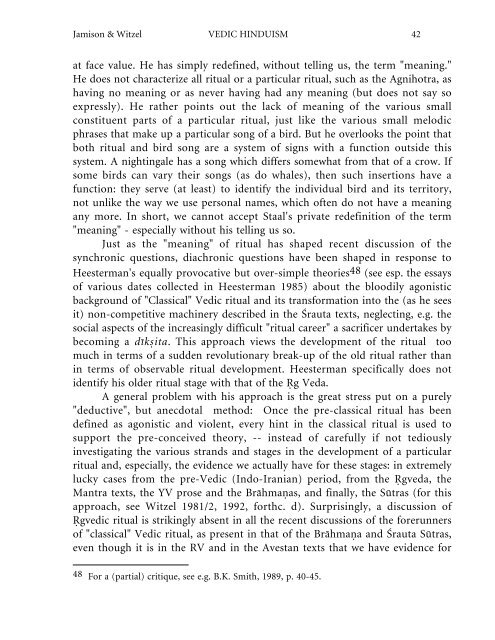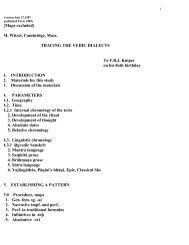VEDIC HINDUISM by S. W. Jamison and M. Witzel - people.fas ...
VEDIC HINDUISM by S. W. Jamison and M. Witzel - people.fas ...
VEDIC HINDUISM by S. W. Jamison and M. Witzel - people.fas ...
You also want an ePaper? Increase the reach of your titles
YUMPU automatically turns print PDFs into web optimized ePapers that Google loves.
<strong>Jamison</strong> & <strong>Witzel</strong> <strong>VEDIC</strong> <strong>HINDUISM</strong> 42<br />
at face value. He has simply redefined, without telling us, the term "meaning."<br />
He does not characterize all ritual or a particular ritual, such as the Agnihotra, as<br />
having no meaning or as never having had any meaning (but does not say so<br />
expressly). He rather points out the lack of meaning of the various small<br />
constituent parts of a particular ritual, just like the various small melodic<br />
phrases that make up a particular song of a bird. But he overlooks the point that<br />
both ritual <strong>and</strong> bird song are a system of signs with a function outside this<br />
system. A nightingale has a song which differs somewhat from that of a crow. If<br />
some birds can vary their songs (as do whales), then such insertions have a<br />
function: they serve (at least) to identify the individual bird <strong>and</strong> its territory,<br />
not unlike the way we use personal names, which often do not have a meaning<br />
any more. In short, we cannot accept Staal's private redefinition of the term<br />
"meaning" - especially without his telling us so.<br />
Just as the "meaning" of ritual has shaped recent discussion of the<br />
synchronic questions, diachronic questions have been shaped in response to<br />
Heesterman's equally provocative but over-simple theories48 (see esp. the essays<br />
of various dates collected in Heesterman 1985) about the bloodily agonistic<br />
background of "Classical" Vedic ritual <strong>and</strong> its transformation into the (as he sees<br />
it) non-competitive machinery described in the Śrauta texts, neglecting, e.g. the<br />
social aspects of the increasingly difficult "ritual career" a sacrificer undertakes <strong>by</strong><br />
becoming a dīk�ita. This approach views the development of the ritual too<br />
much in terms of a sudden revolutionary break-up of the old ritual rather than<br />
in terms of observable ritual development. Heesterman specifically does not<br />
identify his older ritual stage with that of the �g Veda.<br />
A general problem with his approach is the great stress put on a purely<br />
"deductive", but anecdotal method: Once the pre-classical ritual has been<br />
defined as agonistic <strong>and</strong> violent, every hint in the classical ritual is used to<br />
support the pre-conceived theory, -- instead of carefully if not tediously<br />
investigating the various str<strong>and</strong>s <strong>and</strong> stages in the development of a particular<br />
ritual <strong>and</strong>, especially, the evidence we actually have for these stages: in extremely<br />
lucky cases from the pre-Vedic (Indo-Iranian) period, from the �gveda, the<br />
Mantra texts, the YV prose <strong>and</strong> the Bråhma�as, <strong>and</strong> finally, the Sūtras (for this<br />
approach, see <strong>Witzel</strong> 1981/2, 1992, forthc. d). Surprisingly, a discussion of<br />
�gvedic ritual is strikingly absent in all the recent discussions of the forerunners<br />
of "classical" Vedic ritual, as present in that of the Bråhma�a <strong>and</strong> Śrauta Sūtras,<br />
even though it is in the RV <strong>and</strong> in the Avestan texts that we have evidence for<br />
48 For a (partial) critique, see e.g. B.K. Smith, 1989, p. 40-45.

















